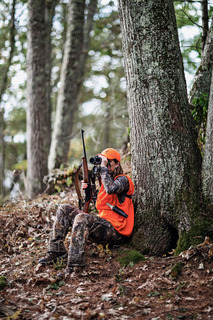Protect Maine's white-tailed deer
Do your part to keep Chronic Wasting Disease (CWD) out of Maine

-
Follow Maine’s import laws. It is illegal to transport wild deer, caribou, moose, or elk carcass parts into Maine from any state or province except NH. Hunters may return to Maine only with boned-out meat, hardened antlers (with or without skull caps), hides without the head portion, and finished taxidermy mounts. If still attached, skull caps should be cleaned free of brain and other tissues.
- When hunting out of state, take extra precautions. When hunting deer, moose, caribou, or elk outside of Maine, take necessary steps to avoid handling, transporting, or consuming CWD-infected specimens, click here for instructions. Hunters returning from hunts in jurisdictions with CWD should very thoroughly clean their gear (such as boots + knives) before returning to Maine and entering the Maine woods.
-
Don’t use urine-based lures. Instead, hunters should use synthetic, non-urine-based lures.
|
CWD is a fatal nervous system disease that impacts cervid (deer family) mammals. In deer, it has a 100% mortality rate and would be devastating to Maine’s deer hunting tradition.
CWD has not been detected in Maine. The nearest population with CWD is in Pennsylvania, though it was found in New York in 2005 (but not since). We continue to monitor and test Maine's cervid populations for CWD. Together we can help protect Maine's white-tailed deer.
Be aware of Epizootic Hemorrhagic Disease (EHD) and Bluetongue Virus (BT)
Epizootic Hemorrhagic Disease (EHD) as well as Bluetongue Virus (BT) are illnesses caused by two similar viruses impacting white-tailed deer with EHD being more common in deer. These viruses are transmitted by the biting midge, Culicoides. Although not yet detected in Maine, EHD was detected in New Hampshire and Vermont in the last couple of years.
EHD is often confirmed when groups of dead deer are found in the wild. If you find multiple dead deer in a small area or dead deer in or very near water with no obvious discernable cause of death, particularly during the late summer or early fall, please contact your local regional office of MDIFW to report the case and consult with a biologist. Learn more about Epizootic Hemorrhagic Disease and Bluetongue Virus.
Protect yourself from mosquito and tick bites
The best way to prevent a mosquito-borne or tickborne disease is to prevent mosquito bites and exposure to ticks. Follow these steps to stay safe.
-
Apply Insect Repellent when Outdoors. Use a repellent with an EPA-registered ingredient, such as DEET, IR3535, permethrin, picaridin (KBR 3023), or oil of lemon eucalyptus (p-menthane-3,8-diol (PMD)) according to the instructions on the product label.
-
Treat Clothing and Gear with Products Containing 0.5% Permethrin. Permethrin can be used to treat boots, clothing and camping gear and remain protective through several washings. Alternatively, you can buy permethrin-treated clothing and gear.
-
Be Aware of Peak Mosquito Hours. The hours from dusk to dawn are peak biting times for many mosquitoes.
-
Know Where to Expect Ticks. Ticks live in grassy, brushy, or wooded areas and are most active April - September.
-
Wear Clothing That Can Help Reduce Mosquito Bites. Wearing long sleeves, long pants and socks when outdoors will help keep mosquitoes away from your skin.
-
Check Yourself and Your Clothing for Ticks. Don't bring ticks inside with you.
|
